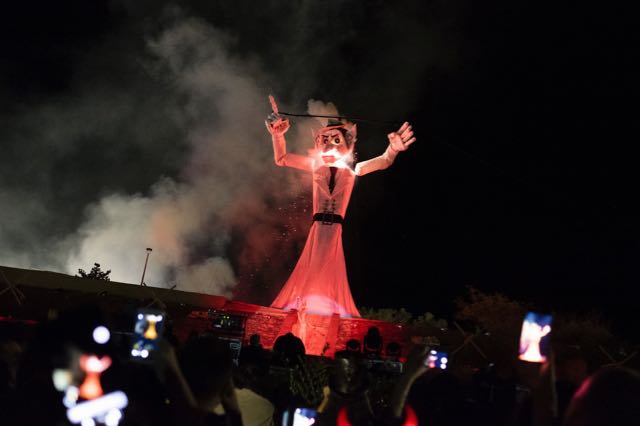By Eduardo Díaz and Kevin Gover
Zozobra, aka Old Man Gloom, in Santa Fe.Cities across the country are grappling with their complicated pasts by removing Confederate statues and renaming schools that honor Confederate leaders, replacing racist Native American sports mascots and abolishing Columbus Day — all vestiges from an earlier time in our country’s history.
The country, it seems, is having a moment. It’s a moment, many of us would argue, that is long overdue.
Now, Santa Fe is adding its voice to the national conversation.
This weekend marks the annual Fiesta de Santa Fe, described by organizers as “the oldest, most colorful community celebration in the nation.”
Dating back to 1712, the event commemorates the Spanish recolonization of Santa Fe with a “mariachi extravaganza”; a giant marionette effigy named Zozobra, aka Old Man Gloom, who was set on fire to the delight of spectators (“At Zozobra, a perfect storm rains down,” Our View, Sept. 5); and food booths featuring everything from chicharrón burritos to Indian frybread.
It also includes a solemn procession to the city’s historic Cathedral Basilica of St. Francis of Assisi for the celebration of a pontifical Mass, reflecting Fiesta’s origins as a religious event honoring the Virgin Mary, or, as she was known for a long time in Santa Fe, La Conquistadora (Our Lady of the Conquest).
Noticeably absent from Fiesta in 2018 was the Entrada, or entrance, a historical pageant held on the Friday of Fiesta.
For more than 100 years, the Entrada had featured a dramatic re-enactment by costumed residents of the moment in 1692 when Spanish conquistadors — conquerors — retook Santa Fe from the Pueblo Indians.
With racial tensions around La Entrada mounting in recent years, the All Pueblo Council of Governors (20 leaders of the sovereign Pueblo nations in New Mexico and Texas) reached out to pageant organizers.
That group, the Caballeros de Vargas, agreed to discontinue the dramatization seen by many Native Americans as a symbol of colonialism and a painful reminder of New Mexico’s bloody past.
Santa Fe’s peaceful resolution is both remarkable and laudable, especially in light of conflicts in other cities that have turned deadly.
For nearly a year, community leaders — including Hispanos, Native Americans and Anglos — engaged in “a respectful and principled deliberative dialogue guided by shared core values … to define a process for genuine reconciliation to heal the wounds of the past and celebrate the beauty of our respective cultures, traditions and peoples,” according to a resolution by the Pueblo Council.
In deciding to “retire” the Entrada, the leaders announced, among other measures, the establishment of a Truth and Reconciliation Commission “to plan and redesign a more inclusive and celebratory commemoration.”
As former residents of Northern New Mexico, we’re glad to see this symbol of colonialism eliminated.
Not everyone in Santa Fe and beyond will agree with us, or with the decision of community leaders. Emotions about the Entrada run deep. But history keeps changing because Americans keep changing it.
As the country continues to grapple with its complicated past and painful history, we encourage leaders of cities around the country to recognize the importance of civil conversations in a democratic society.

We encourage Americans of all points of view to recognize the importance of accuracy in how we represent and honor history in public ceremony and public places.
We owe it to ourselves to figure out what is worthy of celebration and memorialization — and what is not — and how we choose to tell our history.
One thing we know for sure: Respectful conversation and thoughtful listening are better ways to resolve differences than hatred, blame and violence.
If anything, that is the lesson of Santa Fe as it honors in new ways its history, multicultural legacies and unique blend of traditions. ¡Viva! La Fiesta!
Eduardo Díaz is director of the Smithsonian Latino Center and Kevin Gover (Pawnee) is director of the Smithsonian National Museum of the American Indian.





